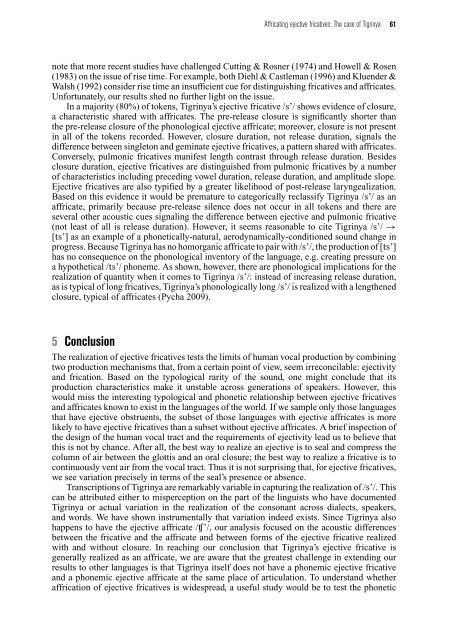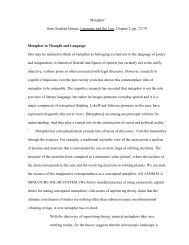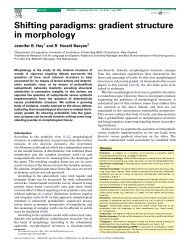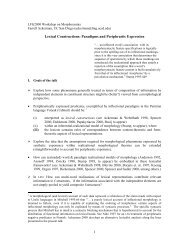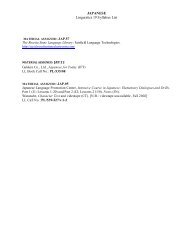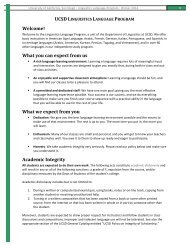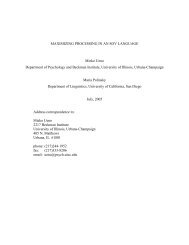Affricating ejective fricatives: The case of Tigrinya - Linguistics
Affricating ejective fricatives: The case of Tigrinya - Linguistics
Affricating ejective fricatives: The case of Tigrinya - Linguistics
You also want an ePaper? Increase the reach of your titles
YUMPU automatically turns print PDFs into web optimized ePapers that Google loves.
<strong>Affricating</strong> <strong>ejective</strong> <strong>fricatives</strong>: <strong>The</strong> <strong>case</strong> <strong>of</strong> <strong>Tigrinya</strong> 61note that more recent studies have challenged Cutting & Rosner (1974) and Howell & Rosen(1983) on the issue <strong>of</strong> rise time. For example, both Diehl & Castleman (1996) and Kluender &Walsh (1992) consider rise time an insufficient cue for distinguishing <strong>fricatives</strong> and affricates.Unfortunately, our results shed no further light on the issue.In a majority (80%) <strong>of</strong> tokens, <strong>Tigrinya</strong>’s <strong>ejective</strong> fricative /s’/ shows evidence <strong>of</strong> closure,a characteristic shared with affricates. <strong>The</strong> pre-release closure is significantly shorter thanthe pre-release closure <strong>of</strong> the phonological <strong>ejective</strong> affricate; moreover, closure is not presentin all <strong>of</strong> the tokens recorded. However, closure duration, not release duration, signals thedifference between singleton and geminate <strong>ejective</strong> <strong>fricatives</strong>, a pattern shared with affricates.Conversely, pulmonic <strong>fricatives</strong> manifest length contrast through release duration. Besidesclosure duration, <strong>ejective</strong> <strong>fricatives</strong> are distinguished from pulmonic <strong>fricatives</strong> by a number<strong>of</strong> characteristics including preceding vowel duration, release duration, and amplitude slope.Ejective <strong>fricatives</strong> are also typified by a greater likelihood <strong>of</strong> post-release laryngealization.Based on this evidence it would be premature to categorically reclassify <strong>Tigrinya</strong> /s’/ as anaffricate, primarily because pre-release silence does not occur in all tokens and there areseveral other acoustic cues signaling the difference between <strong>ejective</strong> and pulmonic fricative(not least <strong>of</strong> all is release duration). However, it seems reasonable to cite <strong>Tigrinya</strong> /s’/ →[ts’] as an example <strong>of</strong> a phonetically-natural, aerodynamically-conditioned sound change inprogress. Because <strong>Tigrinya</strong> has no homorganic affricate to pair with /s’/, the production <strong>of</strong> [ts’]has no consequence on the phonological inventory <strong>of</strong> the language, e.g. creating pressure ona hypothetical /ts’/ phoneme. As shown, however, there are phonological implications for therealization <strong>of</strong> quantity when it comes to <strong>Tigrinya</strong> /s’/: instead <strong>of</strong> increasing release duration,as is typical <strong>of</strong> long <strong>fricatives</strong>, <strong>Tigrinya</strong>’s phonologically long /s’/ is realized with a lengthenedclosure, typical <strong>of</strong> affricates (Pycha 2009).5 Conclusion<strong>The</strong> realization <strong>of</strong> <strong>ejective</strong> <strong>fricatives</strong> tests the limits <strong>of</strong> human vocal production by combiningtwo production mechanisms that, from a certain point <strong>of</strong> view, seem irreconcilable: ejectivityand frication. Based on the typological rarity <strong>of</strong> the sound, one might conclude that itsproduction characteristics make it unstable across generations <strong>of</strong> speakers. However, thiswould miss the interesting typological and phonetic relationship between <strong>ejective</strong> <strong>fricatives</strong>and affricates known to exist in the languages <strong>of</strong> the world. If we sample only those languagesthat have <strong>ejective</strong> obstruents, the subset <strong>of</strong> those languages with <strong>ejective</strong> affricates is morelikely to have <strong>ejective</strong> <strong>fricatives</strong> than a subset without <strong>ejective</strong> affricates. A brief inspection <strong>of</strong>the design <strong>of</strong> the human vocal tract and the requirements <strong>of</strong> ejectivity lead us to believe thatthis is not by chance. After all, the best way to realize an <strong>ejective</strong> is to seal and compress thecolumn <strong>of</strong> air between the glottis and an oral closure; the best way to realize a fricative is tocontinuously vent air from the vocal tract. Thus it is not surprising that, for <strong>ejective</strong> <strong>fricatives</strong>,we see variation precisely in terms <strong>of</strong> the seal’s presence or absence.Transcriptions <strong>of</strong> <strong>Tigrinya</strong> are remarkably variable in capturing the realization <strong>of</strong> /s’/. Thiscan be attributed either to misperception on the part <strong>of</strong> the linguists who have documented<strong>Tigrinya</strong> or actual variation in the realization <strong>of</strong> the consonant across dialects, speakers,and words. We have shown instrumentally that variation indeed exists. Since <strong>Tigrinya</strong> alsohappens to have the <strong>ejective</strong> affricate /’/, our analysis focused on the acoustic differencesbetween the fricative and the affricate and between forms <strong>of</strong> the <strong>ejective</strong> fricative realizedwith and without closure. In reaching our conclusion that <strong>Tigrinya</strong>’s <strong>ejective</strong> fricative isgenerally realized as an affricate, we are aware that the greatest challenge in extending ourresults to other languages is that <strong>Tigrinya</strong> itself does not have a phonemic <strong>ejective</strong> fricativeand a phonemic <strong>ejective</strong> affricate at the same place <strong>of</strong> articulation. To understand whetheraffrication <strong>of</strong> <strong>ejective</strong> <strong>fricatives</strong> is widespread, a useful study would be to test the phonetic


